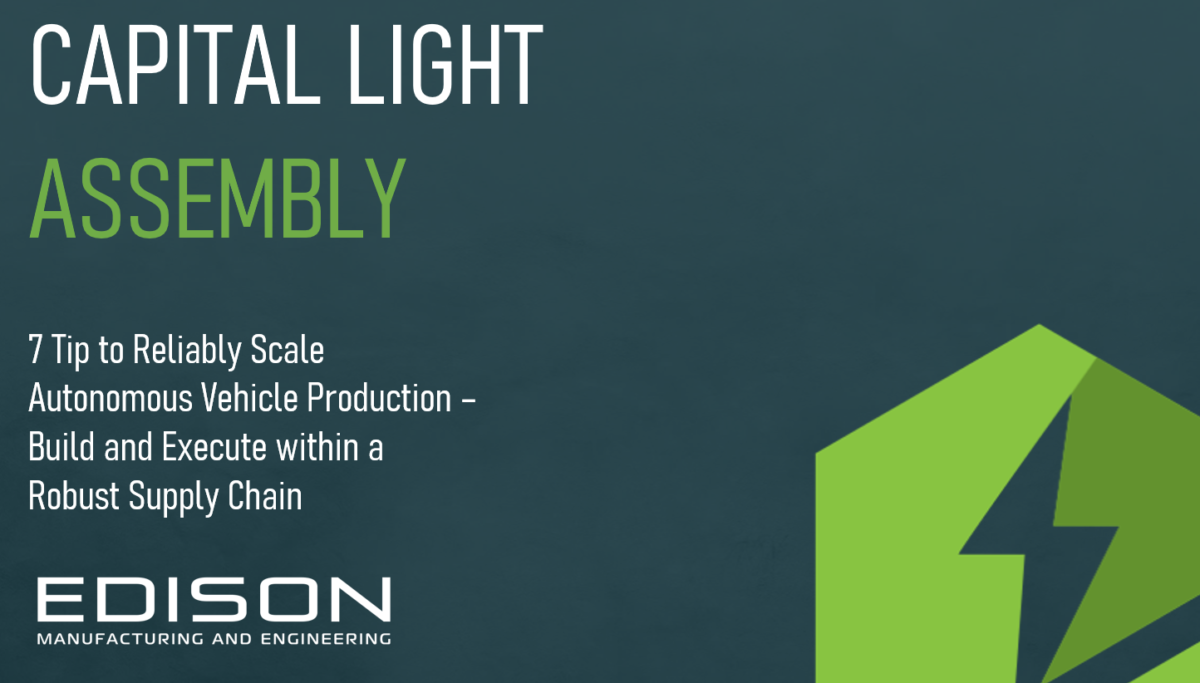The sixth episode of our CLA podcast series, "7 Tips to Reliably Scale Autonomous Vehicle Production," sheds light on the significance of optimizing the right things for your business in manufacturing processes. Brandon Bartneck, VP and GM of Edison, discusses how optimizing items for your business, rather than for the project at hand, can play a significant role in long-term success. So, tune in now to learn more about optimizing for the right things in autonomous vehicle manufacturing processes!
The following questions are addressed in this video:
- What variables should be optimized during prototype builds?
- What should be optimized for low-volume production?
- Why is supplier delivery and quality so important?
- Why is a comprehensive outlook critical here?
Key themes include:
- Cost
- Manufacturing optimization
- Continuous improvement
- Production strategy
Key Takeaways:
- Optimize your autonomous vehicle production lines for your business, not just for current project runs or upfront goals.
- Incremental savings aren’t worth the cost of major issues down the line. Think about this with every decision you’re making for production.
- Optimization is going to look different for every situation and every business. Do what makes the most sense for you.
Full Transcript:
Welcome to the Capital Light Assembly Podcast, brought to you by Edison Manufacturing and Engineering. Edison is your contract manufacturing partner focused on the capital-efficient assembly of complex mobility and mobility-adjacent products that are not well suited for highly automated production. I’m Brandon Bartneck, vice president and general manager here at Edison, and you’re listening to part of a special series focused on how to reliably scale the production of autonomous vehicles.
So, how can you execute and scale that production? Building autonomous vehicles is part of our core business. It’s an area where we have a lot of experience and expertise. We’re using this series as a way to share some of that knowledge with anyone who’s going through this process, so I hope you enjoy it. There are seven tips total and seven episodes here, so check out the ones before and after this, and please enjoy!
The next tip is to choose the right things to optimize. So, there isn't a one-size-fits-all solution here, but the common thread is to be intentional about what you're optimizing and optimize for the most important attributes for your business—not for a specific aspect of your business, not for a given build or component, but for the business overall. And that's tough to put into practice, but I'll give an example here of what that might look like.
The supply chain is a pretty good example. You might think that in many places, a buyer's role is to get the lowest price given the product rate. That works in some places, but it doesn’t really work here.
So, you need, you want a low price, and a low price is better than a high price, and you want the cost or the price that you pay to provide a cost structure that allows you to run a profitable business. That's all true. You don't want to overpay things. You want to pay a fair price. Yes, price is important. I'm not going to say otherwise. It's not the most important thing, though. That is not the variable that you're optimizing. What you're optimizing is the ability to build your components and your product at a reasonable cost while actually delivering good quality products on time.
We talked about previously that supply chain issues have a huge impact. You cannot build if you have issues, such as a missing or bad part. And so that's what you're trying to avoid.
Again, there’s no one-size-fits-all solution, but often, whatever incremental savings you'll have by beating a supplier down or picking the lowest-cost supplier are dwarfed if there's an issue—whether it's a build stop, a warranty issue, or something else. Having a high-quality product on time at a reasonable cost is often what you're trying to optimize from a supply chain perspective.
That's just one example, but it's important to think about the needs of this business in the autonomy space and understand what truly moves the needle and what we, as an organization and as a business, need to do right to continue doing what we're doing and to have long-term success.
And yeah, I think there are traps throughout the organization that you should look out for. I mentioned supply chain cost optimization as one of them, but I'll leave it here for the general tip, which is to choose the right things to optimize.
Make sure to follow along with this series as we answer some of the following questions:
- How can autonomous vehicles be built at scale?
- How can AV companies bring their hardware products to the market?
- How can common manufacturing mistakes be avoided?
- How does automotive know-how and experience apply in the AV space?
Subscribe to our podcast channels and never miss an episode!



